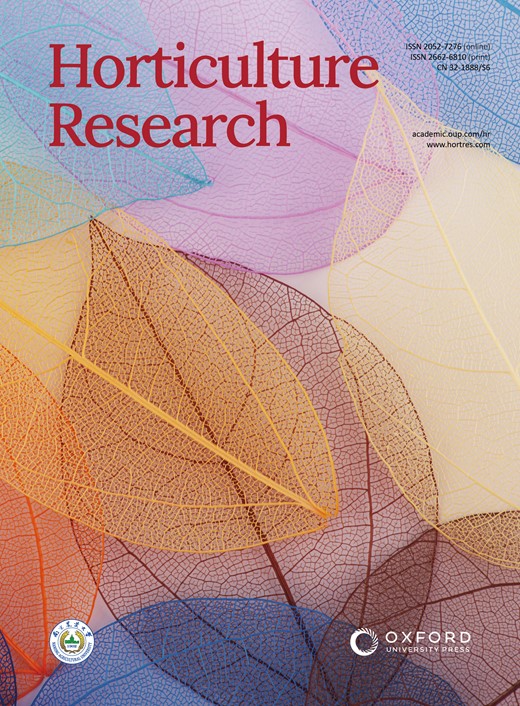Phenotyping, genetics and ‘-omics’ approaches to unravel and introgress enhanced resistance against apple scab (Venturia inaequalis) in apple cultivars (Malus × domestica)
IF 8.7
1区 农林科学
Q1 Agricultural and Biological Sciences
引用次数: 0
Abstract
Apple scab disease, caused by the fungus Venturia inaequalis, endangers commercial apple production globally. It is predominantly managed by frequent fungicide sprays that can harm the environment and promote the development of fungicide-resistant strains. Cultivation of scab-resistant cultivars harboring diverse qualitative Rvi resistance loci and quantitative trait loci associated with scab resistance could reduce the chemical footprint. A comprehensive understanding of the host-pathogen interaction is, however, needed to efficiently breed cultivars with enhanced resistance against a variety of pathogenic strains. Breeding efforts should not only encompass pyramiding of Rvi loci and their corresponding resistance alleles that directly or indirectly recognize pathogen effectors, but should also integrate genes that contribute to effective downstream defense mechanisms. This review provides an overview of the phenotypic and genetic aspects of apple scab resistance, and currently known corresponding defense mechanisms. Implementation of recent ‘-omics’ approaches has provided insights into the complex network of physiological, molecular and signaling processes that occur before and upon scab infection, thereby revealing the importance of both constitutive and induced defense mechanisms. Based on the current knowledge, we outline advances towards more efficient introgression of enhanced scab resistance into novel apple cultivars by conventional breeding or genetic modification techniques. However, additional studies integrating different ‘-omics’ approaches combined with functional studies will be necessary to unravel effective defense mechanisms as well as key regulatory genes underpinning scab resistance in apple. This crucial information will set the stage for successful knowledge-based breeding for enhanced scab resistance.用表型分析、遗传学和 "组学 "方法揭示和导入苹果栽培品种(Malus × domestica)对苹果疮痂病(Venturia inaequalis)的增强抗性
由真菌 Venturia inaequalis 引起的苹果疮痂病危及全球苹果的商业生产。苹果疮痂病主要通过频繁喷洒杀真菌剂来控制,但这会对环境造成危害,并促进抗真菌剂菌株的发展。培育抗疮痂病的栽培品种,使其具有不同的 Rvi 抗性基因座和与抗疮痂病相关的数量性状基因座,可以减少化学足迹。然而,要有效培育出对各种病原菌株具有更强抗性的栽培品种,还需要全面了解寄主与病原菌之间的相互作用。育种工作不仅应包括直接或间接识别病原体效应因子的 Rvi 基因座及其相应抗性等位基因的金字塔化,还应整合有助于有效下游防御机制的基因。本综述概述了苹果疮痂病抗性的表型和遗传方面,以及目前已知的相应防御机制。最近 "组学 "方法的实施使我们对疮痂病感染前和感染后发生的复杂生理、分子和信号转导过程网络有了更深入的了解,从而揭示了组成型和诱导型防御机制的重要性。基于现有知识,我们概述了通过传统育种或转基因技术更有效地将增强的疮痂病抗性导入新的苹果栽培品种的进展。然而,还需要进行更多的研究,将不同的 "组学 "方法与功能研究相结合,以揭示有效的防御机制以及支撑苹果抗疮痂病的关键调控基因。这些关键信息将为成功进行基于知识的育种以增强疮痂病抗性奠定基础。
本文章由计算机程序翻译,如有差异,请以英文原文为准。
求助全文
约1分钟内获得全文
求助全文
来源期刊

Horticulture Research
Biochemistry, Genetics and Molecular Biology-Biochemistry
CiteScore
11.20
自引率
6.90%
发文量
367
审稿时长
20 weeks
期刊介绍:
Horticulture Research, an open access journal affiliated with Nanjing Agricultural University, has achieved the prestigious ranking of number one in the Horticulture category of the Journal Citation Reports ™ from Clarivate, 2022. As a leading publication in the field, the journal is dedicated to disseminating original research articles, comprehensive reviews, insightful perspectives, thought-provoking comments, and valuable correspondence articles and letters to the editor. Its scope encompasses all vital aspects of horticultural plants and disciplines, such as biotechnology, breeding, cellular and molecular biology, evolution, genetics, inter-species interactions, physiology, and the origination and domestication of crops.
 求助内容:
求助内容: 应助结果提醒方式:
应助结果提醒方式:


